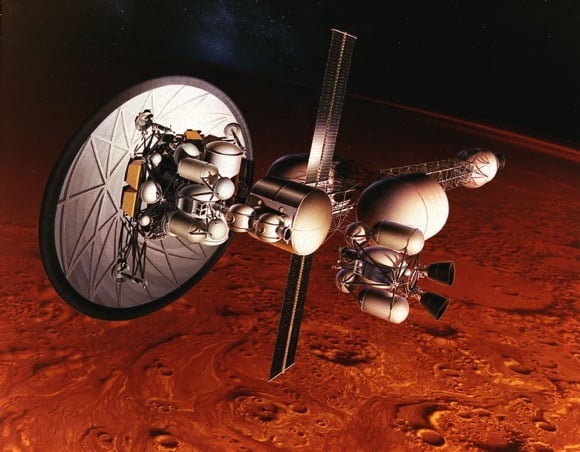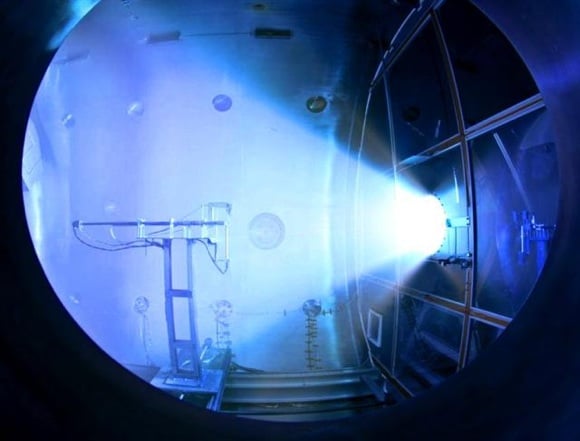Original URL: https://www.theregister.com/2011/11/15/nasa_nuclear_rocket_report/
NASA working on nuclear rocket for manned Mars trips
Should result in 'nauts receiving less radiation
Posted in Science, 15th November 2011 10:02 GMT
Since being redirected away from Bush-era plans for a base on the Moon towards a manned Mars mission, NASA has realigned its nuclear-tech-in-space efforts away from a Moonbase powerplant and towards an atomic-powered rocket able to get astronauts to the red planet quickly, without receiving dangerous exposure to cosmic radiation.

What? It's the year 2011 and you're still mucking about with lousy chemical rockets?
Most plans for a Mars mission assume a ship propelled by ordinary chemical rockets of the type used in all manned missions so far. These get through fuel very rapidly and can only throw it out of their exhausts at a limited rate, putting a strict cap on the speed a Mars ship can achieve if it is to slow down again at its destination and then return. Thus it's generally assumed – as in a recent simulated voyage – that the journey out and back would involve spending a year or more in space.
The big problem with this, one that has yet to really be addressed, is that space is full of dangerous radiation. Normal background cosmic rays are bad enough over a long period: furthermore over a lengthy voyage it's almost certain that there would be one or more major solar storms which could easily take astronauts over their permitted safe dose limits for the entire journey in a matter of days. Sufficient shielding to make a spaceship safe would be so heavy that the craft could probably never be lifted off Earth at reasonable cost.
The only people who have ever been subject to these hazards were the Apollo moon astronauts of yesteryear, and their journeys beyond the protective magnetic fields of Earth were only days long. Even then an inopportune solar event during an Apollo mission could have had disastrous consequences.
For all these reasons, it would be a good idea if more powerful propulsion than chemical rockets could be used for the trip, so cutting down journey time and hazard to the crew. This could also mean less need for supplies, improving the feasibility of the whole plan.
Since nobody has yet come up with any way to provide a thrust in space without throwing reaction mass out of the back of the ship, these various more advanced concepts are still rockets: but they use different means of hurling the mass.
One such concept is to heat the fuel up not by burning it with oxidiser, but using a nuclear reactor. This can potentially make it a lot hotter than mere burning, so expelling it from the exhaust faster and getting more poke out of a given amount of fuel. It was formerly assumed that such rockets would actually become the standard means not of interplanetary travel, but also of normal space launch: the visionaries of the 1940s, if they could have looked ahead to today, would have been dumfounded to find humanity still reliant on feeble chemical propellants (so lame that they have to be used in throwaway multi-stage stacks to achieve orbit) in the year 2011.
The nuclear-safety principle of As Low As Reasonably Achievable on emissions put paid to the idea of using nuclear rockets in atmosphere, though NASA was still working on them as late as 1973 – funnily enough with the idea of using them on manned Mars missions. But the NERVA programme fell victim to the post-Apollo NASA budget cuts, and since then very little work has been done on nuclear rockets as such.
However, under President Bush's Constellation plans, NASA was directed to return to the Moon – and perhaps to establish a permanently manned base there. Such a base would need power, and unless it could be built in a permanently-sunlit spot atop a towering crater rim at one of the lunar poles, solar power would not be an option as most of the Moon is subject to extremely cold two-week-long nights.
Thus, boffins at NASA's Marshall Space Flight Center began work on a small nuclear reactor that could be shipped to the Moon. That plan lost its purpose when President Obama, having found that Congress wouldn't authorise enough cash to pay for the Constellation moon plans, scrapped the idea and laid out vague aspirations for manned deep-space missions to other destinations – including Mars.
Nuclear thermal, or electric plasma rocket?
Some parts of NASA don't seem to be paying a lot of attention to what the President says, but it seems that the nuclear boffins at Marshall aren't in that camp. They have obediently changed the direction of their research from generating power for a base to nuclear-thermal propulsion, according to this report by Aviation Week.

An alternative approach.
The Marshall team, according to Av Week, are not yet using actual nuclear materials in their experiments; rather they're using heaters to simulate these, and looking to build the rest of the rocket. The chosen reaction mass is hydrogen, which being a very light atom can be squirted out of a rocket very fast while still at a temperature low enough not to melt the nozzle.
“Because you can use hydrogen as a propellant, which has a very low molecular weight, a nuclear thermal rocket allows you to get a very high specific impulse even at reasonable material temperatures,” NASA engineer Dave Houts tells the magazine. “We should be able to able to achieve a 900-second specific impulse or better, so you’re roughly twice that of a chemical engine. We think we can go up from there using some of the advanced materials, advanced cycles and advanced geometries in the actual system.”
There are alternative space nuclear-propulsion strategies to thermal rockets. One such is the Variable Specific Impulse Magnetoplasma Rocket, brainchild of former Shuttle astronaut Franklin Chang Díaz. This works by shooting Argon or Krypton fuel out of its exhaust using electromagnetic fields rather than a physical nozzle. The tiny amounts of fuel can thus be blasted out unimaginably violently. Chang Díaz and his team, based on successful ground trials, believe they can deliver no less than 4800 seconds of specific impulse – provided their electric rocket can be furnished with a hefty 210 kilowatts of power.
There's only one spacecraft in existence with that sort of juice at its disposal: the 400-tonne International Space Station, which has the largest solar-panel array ever put into space. Even the ISS could never furnish 210 kW uninterruptedly – it needs power for other things – and its panels would yield less power at Mars, further out from the Sun. Solar-powered VASIMR ships might do for slow unmanned missions, but Chang Díaz says that powerful nuclear reactors would be needed for fast manned journeys. He calculates that nuclear VASIMR ships could reach Mars in as little as a month, as opposed to six months for a chemical-rocket job which would have to coast almost all the way unpowered to save fuel.
This approach would, of course, present its own problems. Nuclear reactors generally produce more heat than electric power, and an atomic VASIMR ship wouldn't be able to throw away its waste heat into cooling towers. Getting rid of heat from its reactor would probably be a major engineering challenge, as all the best cooling mechanisms would be useless in the vacuum of space. The NASA Marshall approach, though offering much less poke, would at least have the benefit that a lot of heat would be carried out of the reactor by the hydrogen reaction mass.
Acknowledging this, Chang Díaz's Ad Astra Rocket Company says that new and better space reactors would be required for fast Mars missions:
It is abundantly clear that the nuclear reactor technology required for such missions is not available today and major advances in reactor design and power conversion are needed. However, a number of serious research studies have been conducted that point to reactor and power conversion designs that meet the kg/kW required for such a mission. Again, much remains to be done, and closing the door on these possibilities on the basis of the relatively primitive state of our present nuclear space technology would be highly premature.
A flight-ready 200kW VASIMR is being built, and is tentatively scheduled for installation aboard the ISS in 2014. the idea would be to use it to maintain the station's orbital speed, which is continually being eroded by the tiny drag exerted on it by the upper reaches of Earth's atmosphere (an issue exacerbated, as it happens, by the station's huge solar panels). At present several tonnes of chemical fuel must be shipped up to the ISS every year for orbit-maintenance purposes, so the super-efficient VASIMR could pay its way very swiftly.
A private firm like Ad Astra can probably never muster the permissions and resources needed to make spacegoing reactors for use beyond Earth orbit, however, so those who'd like to see boots on Mars within a lifetime will probably be glad to hear that the US government is also looking seriously into atomic technology for use in space.
However there will also be those who look on any such move with fear. The Cassini mission to Saturn, which has provided so many excellent and exciting discoveries, has a radioisotopic power unit (simpler but much less powerful than a proper reactor). This was sufficient to cause quite a lot of protest when it was launched, with anti-nuclear fruitcakes dubbing the mission "sheer and utter madness". ®